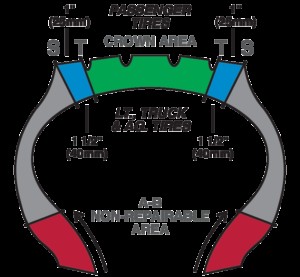Dealing with a flat tire is a common and frustrating experience for drivers. A puncture can occur unexpectedly, leaving you stranded and needing a quick solution. While temporary fixes like tire plugs and strings might seem convenient, understanding the correct way to repair a car tire puncture is crucial for your safety and the longevity of your tire. This guide will walk you through the proper steps for tire repair, emphasizing why shortcuts can be dangerous and what constitutes a safe, industry-standard repair.
Understanding the Limitations of Temporary Tire Repairs
It’s tempting to rely on quick fixes when you encounter a tire puncture. Tire plug and string repairs are often marketed as easy roadside solutions. These methods involve inserting a sticky, rubberized plug or string into the puncture wound from the outside of the tire, without removing the tire from the wheel. While these repairs can effectively stop air from leaking and get you moving again, they are not intended to be permanent.
The primary issue with plug and string repairs is that they only address the symptom (air leakage) and not the root cause of the problem – the puncture itself. These methods do not create a complete seal of the injury channel from the inside of the tire. This allows moisture and air to penetrate the tire’s structure over time. This penetration can lead to steel belt corrosion and weakening of the tire’s internal components, significantly increasing the risk of a dangerous blowout.
Similarly, using only a patch applied to the inside of the tire is also insufficient and unsafe. While a patch can create an airtight seal from within, it, like the plug, fails to fill the puncture channel. This leaves the tire vulnerable to the same issues of moisture and air ingress, compromising its structural integrity and safety over time.
The Industry-Standard Proper Tire Repair Process: R.E.P.A.I.R.
To ensure a safe and lasting tire repair, it’s essential to follow industry-recognized guidelines that involve a combination of patching and plugging from the inside. This method completely seals the puncture from inside the tire, throughout the entire injury channel, preventing air and moisture penetration. A simple acronym to remember the steps for proper tire repair is R.E.P.A.I.R.
Remove the Tire from the Wheel Assembly
The first and crucial step is to remove the tire from the wheel. This is non-negotiable for a proper repair. Removing the tire allows for a thorough inspection of both the internal and external damage. You cannot adequately assess the extent of the puncture or perform a proper repair while the tire remains on the wheel.
Evaluate the Damage Thoroughly
With the tire removed, a detailed evaluation of the puncture is possible. This involves examining the size, angle, and location of the injury. Crucially, you need to determine if the puncture has caused any significant damage to the tire’s internal structure, such as the steel belts or fabric cords. If these components are severely damaged, the tire may be irreparable and must be replaced.
Prepare the Tire for Repair
Once you’ve determined the tire is repairable, preparation is key to ensuring proper adhesion of the repair unit. This step involves:
- Injury Preparation: Using a carbide cutter, the puncture channel is drilled out from the inside. This process removes any damaged cords, debris, and rough edges within the injury, creating a clean path for the plug portion of the repair unit.
- Inner Liner Preparation: The area around the puncture on the tire’s inner liner is cleaned and buffed to create a slightly rough texture. This roughening is essential for maximizing the adhesion of the patch component of the repair unit to the inner liner, ensuring an airtight seal.
Apply Vulcanizing Fluid
Vulcanizing fluid, essentially a specialized rubber cement, is applied to both the prepared injury channel (from the inside) and the buffed area of the inner liner. The vulcanizing fluid acts as a bonding agent, chemically preparing the rubber surfaces for the repair unit. It is crucial to allow the vulcanizing fluid to air dry for the recommended time (typically 5-10 minutes) until it becomes tacky. This ensures optimal bonding.
Install the Patch-Plug Repair Unit
The next step is the installation of a combination patch-plug repair unit. This unit is designed to both fill the injury channel (with the plug portion) and seal the inner liner (with the patch portion).
- Insert the Plug: The plug portion of the repair unit is carefully inserted through the prepared injury channel from the inside of the tire, filling the puncture void.
- Stitch the Patch: The patch portion of the repair unit is then firmly applied to the buffed inner liner area. Using a tire stitcher (a small rolling tool), the patch is thoroughly stitched down, working from the center outwards. This process removes any trapped air bubbles and ensures maximum contact and adhesion between the patch and the inner liner.
- Seal and Trim: After stitching, the over-buffed area of the inner liner surrounding the patch is treated with a thin layer of rubber sealant for added protection. Finally, any excess plug material protruding beyond the tire’s tread surface is trimmed to approximately ¼ inch.
Return to Service – Remount, Inflate, and Balance
The final step is to return the tire to service. This involves:
- Remounting: Carefully remount the repaired tire back onto the wheel rim.
- Inflation: Inflate the tire to the vehicle manufacturer’s recommended pressure.
- Balancing: It is essential to rebalance the wheel and tire assembly after a repair to ensure smooth driving and prevent uneven tire wear.
- Mounting Back on Vehicle: Finally, mount the wheel and tire assembly back onto the vehicle.
When is a Tire Puncture Repairable?
Not all tire punctures can be safely repaired. Several factors determine whether a tire is suitable for repair. These fall into three main categories:
Placement of the Injury
 the repairable are of most tires is restricted to the crown
the repairable are of most tires is restricted to the crown
For passenger car tires, repairs are only considered safe and permissible if the puncture is located within the crown area of the tire. The crown is the central tread area, roughly defined as the area between the outermost grooves. Damage to the shoulder (the rounded edge between the tread and sidewall) or the sidewall itself is not repairable. These areas flex and experience greater stress during normal driving, and repairs in these locations are highly likely to fail, leading to dangerous tire failure.
Size of the Puncture
The size of the puncture also dictates repairability. For most passenger and light truck tires with fabric plies, the maximum repairable puncture size is ¼ inch (6mm) in diameter. For steel-belted light truck, medium, and heavy-duty truck tires, a slightly larger puncture size of up to 3/8 inch (10mm) may be repairable. Punctures larger than these limits often indicate significant internal damage and compromise the tire’s structural integrity beyond safe repair.
Overall Condition of the Tire
The overall condition of the tire is a critical factor. Even if a puncture is within the repairable area and size limits, the tire may still be unsafe to repair if it exhibits any of the following conditions:
- Excessive Wear: Tires nearing the end of their tread life or already worn below the minimum tread depth should generally be replaced rather than repaired.
- Casing Separation: Bulges or distortions in the tire sidewall or tread indicate internal casing separation, a serious condition that renders the tire irreparable and unsafe.
- Impact Damage: Damage from impacts, such as hitting curbs or potholes, can cause internal damage not always visible externally, making repair unsafe.
- Previous Improper Repairs: Evidence of previous plug-only or patch-only repairs can compromise the tire’s structure and may make it unsuitable for a proper repair.
- Run-Flat Damage: If a tire has been driven on while severely underinflated or flat (run-flat condition), even if it’s run-flat capable, it may have sustained irreparable internal damage.
Conclusion: Prioritize Proper Tire Repair for Safety
Encountering a tire puncture is an inevitable part of driving. While quick fixes might offer temporary convenience, they compromise safety in the long run. Proper tire repair, following industry guidelines and the R.E.P.A.I.R. process, is essential for ensuring the safety and reliability of your vehicle. Taking the time to understand the correct procedures and seeking out qualified tire service professionals will ensure that when you repair a car tire puncture, it’s done safely and effectively, giving you peace of mind on the road.

